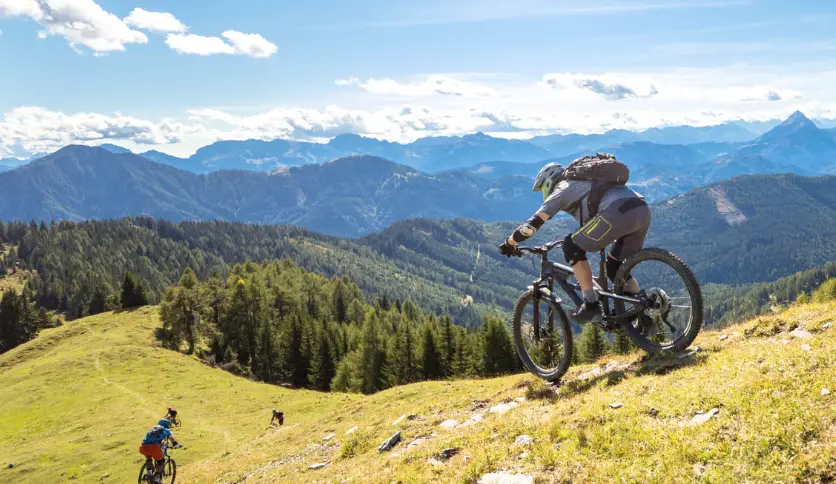Have you ever wondered if mountain bikes are good for road riding? It’s a question that’s been popping up more lately as people discover the surprising versatility of these rugged bikes. While mountain bikes are designed for off-road adventures, they perform pretty well on paved roads, too. In this guide, we’ll dive into mountain bikes on the road, exploring why they’re gaining popularity and uncovering their benefits for road cyclists. So, if you’re curious whether mountain bikes are a good fit for your road riding adventures, stick around—we’ve got all the answers you need.
Understanding the Appeal of Mountain Bikes on the Road
Mountain bikes aren’t just for off-road trails anymore—they’re making their mark on the pavement too! You might be surprised to learn that mountain bikes, with their beefy frames and chunky tires, can handle the smooth surfaces of roads pretty darn well. Here’s why:
First off, let’s talk about those sturdy frames. Mountain bikes are built tough to withstand the bumps and jolts of rugged terrain, which means they’re more than capable of handling the relatively tame surface of roads. That sturdy construction translates to stability and confidence, even when cruising at higher speeds.
Now, let’s talk tires. Mountain bike tires are wider than those found on traditional road bikes, which might seem like overkill for smooth pavement. But those wide tires actually provide a lot of benefits on the road. They offer more grip and traction, so you can easily take corners and tackle uneven surfaces without worrying about slipping and sliding.
But perhaps the best thing about mountain bikes on the road is their versatile gear range. Mountain bikes come equipped with a wide range of gears, which makes it easy to tackle hills, flats, and everything in between. So whether you’re grinding your way up a steep incline or zipping along on a flat stretch of road, your mountain bike has got your back.
So, if you’re thinking about taking your mountain bike out for a spin on the road, go for it! With their stability, comfort, and versatility, mountain bikes are more than up to the task of tackling paved surfaces. Whether you’re commuting to work or going for a leisurely ride on the weekend, your mountain bike is ready to roll.
Advantages of Using Mountain Bikes for Road Riding

Mountain bikes might seem like they belong solely in the wild, but they’re surprisingly good companions for road adventures too. Let’s delve into why:
Increased Comfort and Stability:
Ever felt the jarring bumps of a pothole on your road bike? Mountain bikes have got your back. Their sturdy frames and wide tires soak up those vibrations, giving you a smoother, more comfortable ride, even when the road gets bumpy. It’s like cruising on a cloud compared to the rigid feel of some road bikes.
Enhanced Durability and Robustness:
Road bikes can be delicate creatures, with their slim frames and skinny tires prone to punctures and damage. But mountain bikes? They’re built tough. Their sturdy construction laughs in the face of rough roads and unexpected obstacles. Rocks, gravel, even the occasional curb are no match for a mountain bike’s resilience. So you can ride with confidence, knowing your trusty steed can handle whatever the road throws at it.
Versatile Gear Range:
Ever struggled to conquer a steep hill on your road bike, wishing for an extra boost? Mountain bikes come to the rescue with their wide range of gears. Whether you’re facing a grueling climb or a thrilling descent, you can effortlessly shift gears to find the perfect balance of power and speed. It’s like having a supercharged engine at your fingertips, propelling you up hills and cruising down the other side with ease. So wave goodbye to those uphill battles and enjoy the ride, knowing your mountain bike has got your back.
Addressing Common Concerns and Myths
Contrary to what many people think, mountain bikes aren’t just for rough trails—they can handle the road surprisingly well. Let’s debunk some common misconceptions and myths surrounding mountain bikes on the road.
Misconception about Speed and Efficiency:
One big worry is that mountain bikes are slow and inefficient compared to road bikes. While it’s true that road bikes are built for speed, mountain bikes can still hold their own with a few adjustments. By choosing the right tires and inflating them properly, you can reduce rolling resistance and increase speed. Also, making sure your bike fits you well and adjusting your riding position can significantly affect how efficiently you pedal.
Optimizing Performance:
To get the most out of your mountain bike on the road, it’s important to fine-tune its performance. Adjusting the suspension settings is key—on smooth roads, you’ll want to lock out your suspension or make it firmer to prevent unnecessary bouncing and energy loss. Additionally, paying attention to other aspects of your bike’s setup, like saddle height and handlebar position, can improve comfort and efficiency. With these tweaks, your mountain bike will feel more at home on the road, giving you a smoother and more enjoyable ride.
Choosing the Right Mountain Bike for Road Riding
So, you’re ready to take your mountain bike on the road? Choosing the right bike can make a big difference in your riding experience. Here’s what you need to consider:
Frame Geometry:
When it comes to road riding, the shape of your bike’s frame matters. Look for a mountain bike with a more upright and relaxed geometry. This means the handlebars will be higher and closer to you, making for a more comfortable position, especially during long rides. This upright stance helps reduce strain on your back and neck, so you can enjoy the journey without feeling stiff or sore.
Tire Width:
Next up, let’s talk tires. You’ll want to choose tires with less aggressive tread patterns and higher pressure for road riding. This smooths out your ride and reduces resistance, making pedaling and maintaining speed on paved surfaces easier. The narrower width also helps with efficiency, so you can cover more ground with less effort. Just ensure the tires provide enough grip for cornering and braking, even on smooth roads.
Suspension:
Lastly, consider the suspension on your mountain bike. While suspension is great for soaking up bumps on rough trails, it can actually work against you on the road, sapping energy with each pedal stroke. Look for a mountain bike with a lockout feature on the suspension fork. This allows you to “lock” the suspension in place, essentially turning it off for smoother, more efficient road riding. With the suspension locked out, you’ll waste less energy bouncing around and more energy propelling yourself forward.
By paying attention to these key factors—frame geometry, tire width, and suspension—you can choose a mountain bike that’s optimized for road riding. So, your mountain bike will be ready to roll whether you’re cruising through the city or tackling long country roads.
Tips for Maximizing Road Performance with a Mountain Bike

To make sure your mountain bike performs at its best on the road, here are some simple but effective tips:
1. Tire Selection and Inflation:
- Choosing the right tires can make a big difference. Look for tires with smoother tread patterns, as they’ll roll more smoothly on pavement.
- Inflate your tires to the higher end of the recommended pressure range. This helps reduce rolling resistance, making it easier to pedal and go faster.
2. Suspension Adjustment:
- Most mountain bikes come with suspension forks, which can absorb bumps and shocks on rough terrain. However, for road riding, you’ll want to adjust your suspension settings.
- Set your suspension to a firmer setting or use a lockout feature if your bike has one. This helps prevent unnecessary movement and energy loss, so you can pedal more efficiently.
3. Riding Technique:
- Your riding technique plays a big role in how well your mountain bike performs on the road.
- Maintain a balanced riding position by keeping your weight centered over the bike. This helps improve stability and control, especially when cornering or descending.
- Pedal smoothly and efficiently. Aim for a steady cadence (the speed at which you pedal), as this helps maintain momentum and reduces fatigue.
By following these tips, you can optimize your mountain bike’s performance for road riding. Whether you’re commuting to work or enjoying a leisurely ride on the weekend, these simple adjustments can help make your ride smoother, faster, and more enjoyable.
Long-Term Maintenance and Care
Regular maintenance is crucial to keep your mountain bike performing at its best and to ensure it lasts for many miles of road riding adventures.
Regular Cleaning and Lubrication:
To keep your mountain bike running smoothly on the road, it’s essential to keep it clean and well-lubricated. After each road ride, take a few minutes to wipe down the frame, chain, and other components with a damp cloth to remove any dirt, grime, or debris. This helps prevent buildup that can lead to corrosion and premature wear. Additionally, regularly lubricating your bike’s chain and other moving parts with a quality bike lubricant helps reduce friction, extend the lifespan of your components, and keep your ride feeling smooth.
Component Inspection:
Regularly inspecting your mountain bike’s components is another important part of long-term maintenance. Check your brakes, drivetrain (including the chain, cassette, and derailleur), and suspension for any signs of wear or damage. Look for things like worn brake pads, stretched chains, bent derailleur hangers, or leaking suspension seals. Addressing these issues promptly can prevent further damage and ensure your bike continues to perform safely and efficiently on the road. If you’re unsure how to inspect your bike or identify potential problems, don’t hesitate to seek advice from a knowledgeable friend or your local bike shop.
Professional Tune-ups:
While regular at-home maintenance is essential, scheduling periodic tune-ups with a qualified bike mechanic is also recommended to keep your mountain bike in top condition for road riding. A professional tune-up typically involves a thorough inspection and adjustment of your bike’s components, including brakes, gears, bearings, and suspension. Your mechanic can also check for any hidden issues that may not be visible to the untrained eye and perform more advanced maintenance tasks, such as wheel truing or bottom bracket servicing. By investing in professional tune-ups at least once or twice a year, you can ensure that your mountain bike remains safe, reliable, and enjoyable to ride on the road for years to come.
F&Q For Are Mountain Bikes Good for Road
Can mountain bikes keep up with road bikes in terms of speed?
While mountain bikes may not match the speed of road bikes, they offer comparable performance with proper setup and adjustments.
Are there any disadvantages to using mountain bikes on the road?
Mountain bikes may be slightly heavier and less aerodynamic than road bikes, but they compensate with increased comfort and versatility.
How can I make my mountain bike more suitable for road riding?
Optimize tire selection and inflation, adjust suspension settings, and maintain proper bike fit to enhance your mountain bike’s performance on the road.
Conclusion
So, are mountain bikes good for road riding? The answer is a resounding yes! While mountain bikes are designed for off-road adventures, they offer surprising versatility and comfort on paved roads too. With their sturdy construction, wide gear range, and ability to absorb bumps, mountain bikes are well-suited for tackling everything from daily commutes to long-distance road rides. By understanding the benefits, addressing common concerns, and following proper maintenance practices, cyclists can confidently take their mountain bikes out on the road and enjoy a smooth and enjoyable riding experience. So, whether you’re a seasoned road cyclist looking for a new challenge or a mountain biking enthusiast curious about road riding, grab your mountain bike and hit the road—it’s sure to be an adventure worth exploring!

I am Ryan Ford, a mountain biking enthusiast who loves to explore the outdoors. I also like to go on adventures with friends and anything else that involves being outside. I love my bike because it gets me out of the house and gives me an opportunity to enjoy nature.


